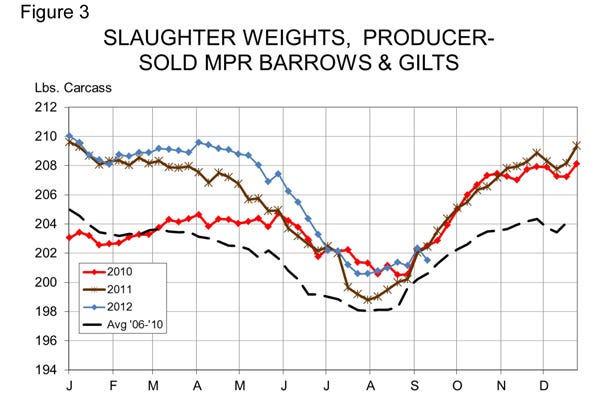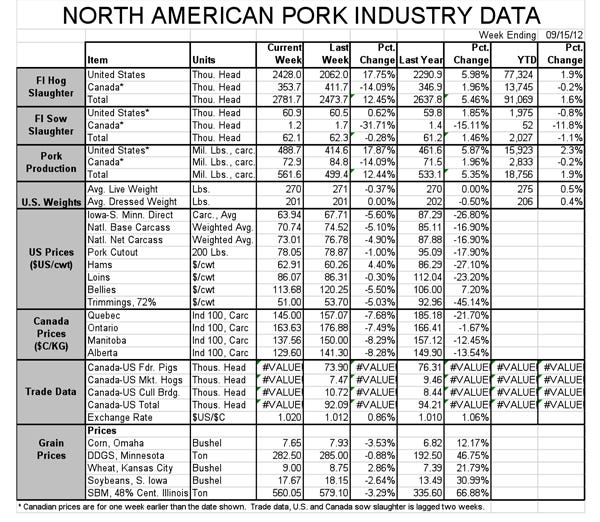The question remains: Where are these hogs coming from? Last week’s FI slaughter run of 2.428 million head was the third highest EVER. It ranks behind only the weeks of December 22, 2007 (2.477 million head) and January 12, 2008 (2.435 million head) – the two largest weeks during a surge of slaughter driven by the thousands of pigs that otherwise would have died if not for the introduction in 2007 of effective circorvirus vaccines.
September 17, 2012

The question remains: Where are these hogs coming from? Last week’s FI slaughter run of 2.428 million head was the third highest EVER. It ranks behind only the weeks of December 22, 2007 (2.477 million head) and January 12, 2008 (2.435 million head) – the two largest weeks during a surge of slaughter driven by the thousands of pigs that otherwise would have died if not for the introduction in 2007 of effective circorvirus vaccines. We can’t blame a technological innovation for this surge but there is, I still believe, a very good reason for it.
I started college as a pre-vet major. However, three things derailed my budding animal-treatment career. First, I lived with a first-year vet student and saw him pouring, night after night, over pictures and charts of bones, muscles, nerves, glands, arteries, veins, etc., etc., in order to memorize them all for his anatomy class. Doesn’t sound like much, but I was having trouble memorizing the fraternity’s phone number. I can remember the most obscure piece of trivia but I don’t “do” memorization on command well. It was one limitation of which I was already aware back in 1976. I’ve learned of a lot of others since then.
Second, the first homework assignment in my required ag econ class was economic evaluation of the costs and benefits of my chosen college major. Needless to say, the cost of becoming a veterinarian was high, even back then. Those four additional years of school were pricey, and the four-year delay in getting a paycheck made it even more so. I decided the payoffs of being a large-animal vet were not terribly high.
Finally, I was in this agricultural economics class that had these broad concepts that seem to apply to many things. Very little memorization required. I thought this may be for me.
Perhaps the most important of the broad concepts was this: Marginal cost (MC) = marginal revenue (MR). That is, of course, the condition that determines the profit-maximizing output of the firm. It holds that, with diminishing marginal productivity, marginal costs (i.e. the cost of producing the next—or marginal – unit of output) are rising. Therefore, the firm should produce more output until the addition to cost is just offset by the price of that last unit. That price is marginal revenue. The reason is clear: Every unit of output up to that point generates more income than cost (MR>MC) thus adding to total profit. Every unit beyond it generates more cost than income (MR<MC) thus deducting from profit. Therefore, MR=MC is where profit is maximized.
All of this personal history and economic gobbledygook is offered as background to what I believe is the very rational response of hog producers to extremely high feed costs. Marginal cost has increased sharply at all output levels due to the rise in feed costs. This is depicted by the move of the MC curve upward to MC’ in Figure 1. The firm’s response would be a drop in output from Q to Q’. If all firms faced similar cost and revenue curves, all would cut output and the market output would drop commensurately.
But marginal cost is not the only thing that has changed. So has marginal revenue due to seasonal factors and the nature of hog producers’ available decision variables. More on that in a bit, but suffice it to say that the MR curve has fallen from MR to MR’ driving another reduction in output, this time to Q’’.
But hog feeders cannot, in the short run, change the number of hogs they sell. There were several million pigs farrowed 26 weeks ago, and weaned 23 weeks ago, and placed into finishing buildings 18 weeks ago. And those pigs, less death loss, have to come to town over a rather limited time period. The only decision variable available is how long they are on feed, and the costs and slaughter weight that result from that decision.
It has appeared for some time that producers were pulling hogs ahead in an effort to a) get to lower levels of marginal cost by shipping pigs at a point where they are more efficient and b) positively impact marginal revenue by reducing the amount of pork that is being placed on the market.
Selling pigs at lighter weights will move marginal costs lower as long as feed prices are not rising faster than the feed efficiency improvement. The reduction in marginal costs may not be enough to move producers to profits, but they will at least reduce losses.
The second impact hasn’t been seen yet because the reduction in weights is being swamped by the increase in numbers. But as can be seen in Figure 3, the impact on weights is clear. Last week, the average weight of producer-sold barrows and gilts reported to USDA under mandatory price reporting fell by 0.9 lb. More important, the decline came during a week that normally sees weight increase by 0.6 lb.
Does this mean we will significantly reduce slaughter in the weeks ahead? Maybe, but maybe not. If feed costs remain high, these incentives to ship pigs lighter will continue and we will simply keep doing so, pulling pigs that would have been sold in the first week or two of January into 2012. I think there will be some impact on Q4 numbers and lower weights, at least relative to what they would have been, will help push prices higher than the level they would have been.
But don’t expect a big shortfall of hogs until the MC=MR equation turns in favor of MR. Only then will producers begin to lengthen feeding periods and reduce the number available in the short run.





About the Author(s)
You May Also Like





